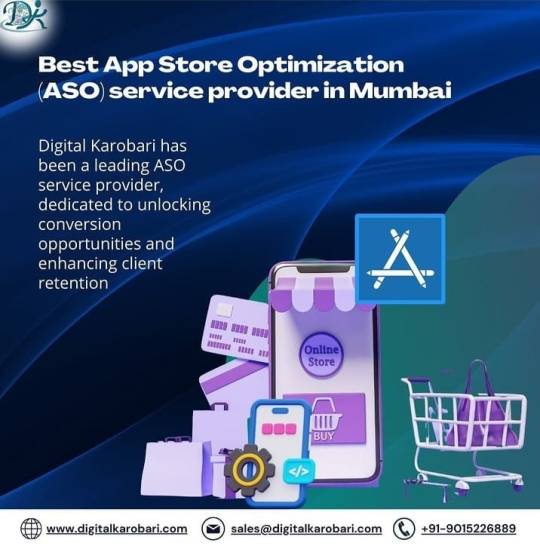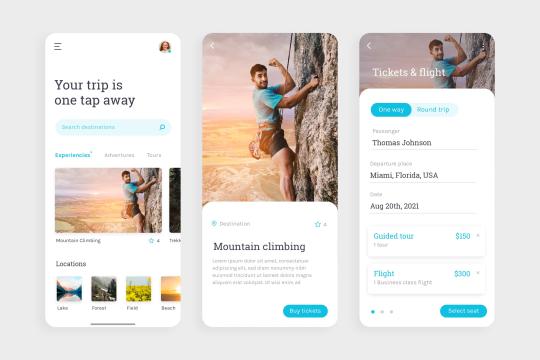#Appoptimization
Explore tagged Tumblr posts
Text
#5G#MobileAppDevelopment#AppPerformance#TechnologyTrends#MobileApps#5GTechnology#AppOptimization#MobileUserExperience#FutureTech#TechInnovation#MobileDevelopment#5GImpact
1 note
·
View note
Text
Best App Store Optimization (ASO) Service Provider Agency in Mumbai - Digital Karobari

#AppStoreOptimization#ASOAgency#ASOServices#AppMarketing#ASOExperts#AppVisibility#AppOptimization#AppStoreASO
0 notes
Text

0 notes
Text
youtube
📱 Take Control of Your Mobile App's Performance with MageNative's Analytics Dashboard!
Want to know how your mobile app is performing? MageNative's powerful Mobile App Analytics Dashboard has got you covered! From tracking user behavior to monitoring conversion rates, our dashboard gives you real-time insights into everything that matters for growing your business.
Watch this quick video to see how easy it is to access key metrics, optimize your app’s performance, and make data-driven decisions to boost your sales and user engagement. Whether you're running a Shopify store or managing any eCommerce app, MageNative’s dashboard helps you stay on top of your game!
Try: MageNative Mobile App Builder
#MobileApp#Analytics#MageNative#EcommerceApps#Shopify#AppPerformance#AppMetrics#Dashboard#DataDriven#BusinessGrowth#AppOptimization#Youtube
0 notes
Text
Innovative Mobile App Development Solutions for Businesses
At SN Digitech, we specialize in creating cutting-edge mobile apps tailored to meet your business needs. Our team of expert developers is committed to delivering user-friendly, secure, and scalable mobile applications that enhance customer engagement and drive business growth. We design custom apps across iOS, Android, and cross-platform frameworks, ensuring seamless functionality and a superior user experience.
From concept to deployment, we follow an agile approach, focusing on performance, reliability, and innovation. Whether it's a startup looking to build an MVP or an established brand aiming to enhance its digital presence, SN Digitech provides end-to-end mobile app development services, including UI/UX design, coding, testing, and post-launch support. Empower your business with our tailor-made mobile solutions and stay ahead in the competitive market.
Let us turn your vision into reality with a powerful mobile app that delivers results!
#MobileAppDevelopment#AppDevelopment#iOSAppDevelopment#AndroidAppDevelopment#CrossPlatformApps#CustomAppDevelopment#MobileSolutions#AppDesign#UIUXDesign#AppDevelopmentServices#MobileAppDesign#BusinessApps#EnterpriseApps#MobileAppDevelopers#AppDevelopmentCompany#AppTesting#AppDeployment#AgileDevelopment#AppOptimization#AppMaintenance
0 notes
Text
In today’s digital-first world, mobile apps are essential for businesses to stay connected with their customers. A well-designed and functional mobile app can help improve customer engagement, drive sales, and enhance brand visibility. At Xaltam, we specialize in mobile app design, development, and maintenance, offering customized solutions tailored to your business’s unique needs.
Mobile App Design: Crafting User-Centric Experiences

Designing a mobile app goes beyond aesthetics. It’s about creating an intuitive user experience that keeps users coming back. At Xaltam, we focus on user-centric design, ensuring that your app is visually appealing and easy to navigate. We incorporate responsive design principles to create apps that work seamlessly across various devices and platforms.
Mobile App Development: Building High-Performance Applications
Once the design is finalized, it’s time to bring the concept to life. At Xaltam, our team of experienced developers uses cutting-edge technologies to build apps that are fast, secure, and scalable. We offer both iOS and Android app development, ensuring that your app reaches a wider audience. With our expertise in cross-platform development, we provide cost-effective solutions that don’t compromise on quality.
Mobile App Maintenance: Keeping Your App at Peak Performance
After your app is live, continuous maintenance is crucial to ensure its smooth functioning. Our maintenance services at Xaltam include regular updates, bug fixes, and performance optimization. We monitor your app to ensure it stays up-to-date with the latest operating system requirements and security standards. Whether it’s adding new features or improving existing ones, we’ve got you covered.
Why Choose Xaltam for Mobile App Solutions?
Customized Solutions: We design and develop apps tailored to your business objectives.
Full-Cycle Services: From design to development and maintenance, we handle it all.
Cost-Effective Development: Cross-platform solutions that save time and resources.
Expert Team: Skilled developers and designers committed to delivering quality.
Choosing Xaltam means partnering with a company that prioritizes both innovation and customer satisfaction. Whether you’re a startup looking to break into the app market or an established business aiming to enhance your digital presence, our mobile app solutions are designed to grow with you.
#MobileAppDesign#AppDevelopment#AppMaintenance#XaltamSolutions#UserExperienceDesign#CrossPlatformDevelopment#MobileAppDevelopment#TechSolutions#AppOptimization#BusinessApps
0 notes
Text
Utilizing A/B Testing for Optimizing User Experience (UX) in Mobile Apps

In today's competitive landscape, delivering an exceptional user experience (UX) is paramount for the success of mobile apps. A/B testing, also known as split testing, is a powerful technique used by mobile app developers and designers to optimize UX design elements and features based on user feedback and behavior. In this article, we'll explore how A/B testing can be effectively utilized to enhance UX in mobile apps and drive better user engagement and satisfaction.
Understanding A/B Testing:
A/B testing is a method used to compare two or more versions of a mobile app or its features to determine which one performs better in terms of user engagement, conversions, or other desired outcomes. In an A/B test, users are randomly assigned to different variations of the app or specific features, and their interactions and behavior are tracked and analyzed to identify the most effective design or feature.
Key Benefits of A/B Testing for Mobile Apps:
1. Data-Driven Decision Making: A/B testing provides empirical data and insights into user behavior, preferences, and performance metrics, allowing app developers to make informed decisions based on real user data rather than assumptions or intuition. 2. Optimized User Experience: By testing different design variations, layouts, features, and user flows, app developers can identify UX elements that resonate most with users and enhance overall usability, navigation, and satisfaction. 3. Continuous Improvement: A/B testing enables iterative optimization of mobile app design and features over time, allowing developers to refine and improve the user experience based on user feedback and performance data. 4. Reduced Risk: A/B testing mitigates the risk of negative user reactions or unintended consequences by testing changes on a subset of users first. This approach rolls out only successful changes to the entire user base.
Best Practices for A/B Testing in Mobile Apps:
1. Define Clear Objectives: Before conducting A/B tests, clearly define the goals and objectives you want to achieve, whether it's increasing user engagement, improving retention rates, or boosting conversion rates. 2. Focus on One Variable: When designing A/B tests, focus on testing one variable at a time to isolate its impact on user behavior and performance metrics. Common variables to test include button colors, call-to-action text, layout variations, and feature placements. 3. Segment User Groups: Segment users based on relevant criteria such as demographics, behavior, or usage patterns, and test different variations on each segment to identify how different user groups respond to changes. 4. Monitor Key Metrics: Track key performance metrics such as click-through rates, conversion rates, session duration, and retention rates to evaluate the effectiveness of A/B test variations and determine which version performs better. 5. Run Tests Concurrently: To maximize efficiency and minimize testing duration, run multiple A/B tests concurrently on different aspects of the app, but ensure that tests do not overlap or influence each other's results. 6. Iterate and Iterate: Continuously analyze test results, draw insights, and iterate on design changes based on user feedback and performance data. A/B testing is an ongoing process of iterative optimization rather than a one-time exercise.
Case Study: A/B Testing in Mobile Gaming App:
Consider a mobile gaming app that wants to increase user engagement and retention. The app developer conducts an A/B test to compare two variations of the app's home screen layout: one with a prominent "Play Now" button and another with a "Featured Games" carousel. After running the A/B test for two weeks and analyzing the results, the developer finds that the variation with the "Play Now" button has a significantly higher click-through rate and session duration compared to the "Featured Games" carousel. As a result, the developer decides to implement the "Play Now" button layout across the entire app to improve user engagement and retention.
Conclusion:
A/B testing is a valuable tool for optimizing user experience in mobile apps by allowing developers to test design variations, features, and user flows to identify what resonates best with users. By leveraging A/B testing, mobile app developers can make data-driven decisions, improve usability, enhance user engagement, and ultimately create a more satisfying and successful app experience for their users. Through continuous testing, iteration, and optimization, A/B testing empowers developers to stay ahead of the curve and deliver exceptional user experiences in the ever-evolving landscape of mobile app development.
0 notes
Text
How to Optimize Your Android App for Performance and Speed 🏎️

In today’s fast-paced digital world, users expect their mobile apps to be lightning-fast and ultra-responsive. Performance is crucial for any successful Android application. Here are some effective strategies to optimize your Android app for performance and speed.
1. Simplify Layouts 🏗️
Complex layouts can slow down your app’s performance. Simplify your layout hierarchies to reduce rendering time.
Tips:
Use efficient layouts.
Avoid nested ScrollViews.
2. Efficient Image Handling 📸
Images can significantly impact performance. Load and cache images efficiently.
Tips:
Use image loading libraries.
Optimize image sizes and formats.
3. Minimize Memory Usage 🧠
Excessive memory usage can lead to slowdowns. Manage memory usage effectively.
Tips:
Avoid memory leaks.
Use efficient data structures.
4. Optimize Network Calls 🌐
Network calls can cause lag. Optimize them to prevent blocking the main thread.
Tips:
Use asynchronous network calls.
Implement caching strategies.
5. Reduce App Size 📦
A smaller app size can improve performance. Reduce the APK size for faster load times.
Tips:
Remove unused resources and code.
Enable resource shrinking.
6. Optimize Database Access 📊
Frequent database access can slow down your app. Optimize database operations for efficiency.
Tips:
Use indexing.
Perform operations on a background thread.
7. Use Profiling Tools 🔍
Identify performance bottlenecks and memory leaks with Android Studio’s profiling tools.
Tips:
Analyze CPU usage.
Track memory allocations.
Monitor network activity
8. Optimize Startup Time ⏱️
A slow startup time can frustrate users. Improve your app’s startup time for better user experience.
Tips:
Avoid heavy operations during initialization.
Use a splash screen.
Preload data asynchronously.
9. Enable Hardware Acceleration 🎨
Improve performance by offloading rendering to the GPU.
Tips:
Enable hardware acceleration.
Optimize custom views.
10. Smooth Animations ✨
Smooth animations enhance user experience. Avoid poorly implemented animations.
Tips:
Use efficient animation techniques.
Reduce overlapping views.
Conclusion 🎯
Optimizing your Android app for performance and speed is essential for providing a seamless user experience. By following these strategies, you can ensure your app runs smoothly, responds quickly, and retains users. Regularly profile your app, identify bottlenecks, and make improvements to maintain optimal performance.
By focusing on these key areas, you can create an Android app that exceeds user expectations in terms of performance and speed.
0 notes
Text
Transforming User Experience: Progressive Web App Development with React and Angular
With this in-depth guide on Progressive Web App (PWA) development, you can explore the future of mobile app development. Discover how to develop smooth, fast PWAs that simulate native apps by utilizing the combined power of Angular and React.
Learn about the benefits of PWAs, such as increased user engagement, quick loading times, and offline capabilities. Our in-depth knowledge will help you navigate the complexities of creating dependable and scalable Progressive Web App development, from basic setup to sophisticated optimization strategies.
Gain a competitive edge in the mobile app development space by becoming an expert in using a progressive web app react and angular progressive web app to create dynamic, responsive, and effective Progressive Web App development.
Whether you're a beginner or an experienced developer, our guide offers valuable tips and best practices for enhancing your skills and delivering top-notch user experiences.
#stigasoft#PWADevelopment#progressive web apps#mobile app development#angular#React#PWABenefits#appoptimization#web app development#FutureOfMobileApps#techinnovation
0 notes
Text
How to Optimize Mobile App Design for Speed

In today’s fast-paced digital world, users demand swift and seamless experiences from mobile applications. A slow app can lead to user frustration, high abandonment rates, and ultimately, negative reviews. Therefore, optimizing mobile app design for speed is crucial for ensuring user satisfaction and achieving high conversion rates. This comprehensive guide explores the best practices for creating a lightning-fast mobile app.
Understanding the Importance of Speed in Mobile App Design
User Expectations and Behavior
Users have become accustomed to instant access and quick interactions. Studies show that the average mobile user expects an app to load within two seconds. If an app takes longer, users are likely to abandon it in favor of a faster alternative. Speed directly impacts user retention, engagement, and overall satisfaction.
Impact on Conversion Rates
Speed is not just about user experience; it also affects conversion rates. A fast app encourages users to stay longer and engage more, increasing the likelihood of conversions, whether it’s making a purchase, signing up for a service, or completing any desired action.
Key Strategies for Optimizing Mobile App Speed
Efficient Coding Practices
Minimize Code Complexity
Writing clean, efficient, and minimal code is fundamental. Reducing the complexity of the codebase helps in faster execution. Avoid redundant code and use efficient algorithms to streamline processes.
Optimize Loops and Conditional Statements
Loops and conditional statements can slow down an app if not optimized. Ensure that loops run efficiently and conditional statements are simplified to reduce processing time.
Image Optimization
Use Compressed Image Formats
Images are often the largest elements in an app, significantly affecting load times. Use compressed formats like JPEG or WebP to reduce file size without compromising quality.
Implement Lazy Loading
Lazy loading defers the loading of images until they are needed, such as when they come into the user’s viewport. This approach reduces initial load times and improves perceived performance.
Data Management
Efficient Data Fetching
Fetch only the necessary data required for the immediate user interaction. Using pagination or infinite scroll can help manage large datasets efficiently.
Cache Data Locally
Local caching reduces the need to fetch data from the server repeatedly. Implementing smart caching strategies ensures that frequently accessed data is available instantly.
Network Optimization
Reduce API Call Overheads
Reduce the quantity of API queries made by grouping requests together.Batch multiple requests into a single call when possible to reduce network overhead.
Use Content Delivery Networks (CDNs)
CDNs distribute content across multiple servers globally, reducing the distance data has to travel. This results in faster load times, especially for global user bases.
Performance Monitoring and Testing
Continuous Performance Testing
Regularly test the app’s performance using automated tools to identify and address bottlenecks. Tools like JMeter and Appium can simulate user interactions and provide detailed performance metrics.
Real-User Monitoring
Implement real-user monitoring to gather performance data from actual users. This provides insights into real-world performance issues that automated testing might miss.
Frontend Optimization
Minimize DOM Elements
A large number of DOM elements can slow down rendering. Keep the DOM tree shallow and reduce the number of elements to enhance rendering speed.
Use Hardware Acceleration
Leverage the device’s GPU for rendering complex graphics and animations. Using CSS properties like transform and opacity can trigger hardware acceleration, improving performance.
Background Processes Management
Optimize Background Tasks
Background tasks can consume resources and slow down the app. Optimize these tasks to run efficiently without impacting the app’s performance. Use background processing judiciously to balance performance and functionality.
Use Efficient Algorithms for Data Processing
Implement efficient algorithms for tasks like data sorting, searching, and filtering. Efficient algorithms reduce processing time and improve overall app speed.
Advanced Techniques for Speed Optimization
Progressive Web App (PWA) Techniques
Implementing PWA techniques can enhance the speed and performance of mobile apps. Features like service workers enable background syncing and caching, providing a seamless user experience even with poor network conditions.
App Bundle Optimization
Use Android App Bundles and iOS App Thinning to optimize the size of your app. These techniques deliver only the necessary resources to the user’s device, reducing download and installation times.
Preloading and Prefetching
Preloading critical resources and prefetching data that might be needed soon can significantly improve load times. This technique anticipates user actions and prepares resources in advance.
Conclusion
Optimizing mobile app design for speed is a multifaceted approach that requires attention to coding practices, image and data management, network optimization, and performance monitoring. By implementing these strategies, you can create a mobile app that meets user expectations, enhances engagement, and drives conversions. Keep in mind that every millisecond matters in the realm of mobile apps.
#MobileAppDesign#AppOptimization#UserExperience#MobilePerformance#FastLoadingApps#EfficientCoding#ImageOptimization#DataManagement#NetworkOptimization#PerformanceTesting#FrontendOptimization#BackgroundProcessing#SpeedOptimization#ProgressiveWebApps#AppBundleOptimization#Preloading#Prefetching#UserRetention#ConversionRates#MobileAppDevelopment#PerformanceMonitoring
0 notes
Text
It's quiz time! 📱🔍Ready to prove your mobile app development skills? Test your knowledge and see how you stack up. Challenge yourself and share your results with friends!
What is the purpose of beta testing in mobile app development? a) To assess user interface design b) To optimize app performance c) To identify and fix bugs before release d) To generate marketing buzz . . ➡️For more information, please visit our website:- https://zoofinc.com/ ➡Your Success Story Begins Here. Let's Grow Your Business with us!
👉Do not forget to share with someone whom it is needed. 👉Let us know your opinion in the comment down below 👉Follow @Zoof Software Solutions for more information . . ✔️Feel free to ask any query at [email protected] ✔️For more detail visit: https://zoof.co.in/ . . .
#MobileAppDevelopment#BetaTesting#AppTesting#AppPerformance#UserInterface#AppRelease#SoftwareTesting#TechQA#AppOptimization#MobileDev#QualityAssurance#webappsoftwaredevelopment#bestITservice#ZoofUnitedStates#ZoofIndia#SoftwareCompany#StartUpTechnology#mobilefriendlywebsite#Resourceoutsourcing#TechnologyConsulting#GrowBusiness#WebsiteDevelopment#SoftwareConsultant#ZoofSoftwareSolutions#zoof#zoofinc#AwardWinningCompany#BestSoftwareCompany#DigitalMarketing
0 notes
Text
"Enhance your app's UI/UX performance with our top-notch optimization services in Patna. At Hexile Service Pvt. Ltd, we specialize in website development and designing in Patna. Elevate your user experience today!"
Call Us:- +91 9319934449 / +91 9334044680
Visit:- https://www.hexileservices.com
#AppOptimization#uiuxdesign#webdesigning#webdevelopment#patnatech#growbusinessonline#hexileservices#T20WorldCup2024#RAVINDRASINGHBHATI#NoVoteToBJP#NehaSharma#ToxicTheMovie#whatsappstatus#kiaraadvani#Facebooking#FacebookPage#instareel#like4likes#PatnaSahib#callnow
0 notes
Text
Best App Store Optimization Services
App Store Optimization Services decorate visibility and downloads for cellular apps. These services rent strategic techniques like keyword optimization, compelling app descriptions, and appealing visuals to enhance an app's rating in-app shop seek outcomes. With expertise in user behavior and market trends, ASO specialists optimize metadata and content, making sure the app aligns with applicable search queries. Improved discoverability interprets to elevated natural downloads, in the long run enhancing an app's success in a competitive digital panorama.
0 notes
Text
One small app has the power to influence the masses, and the same can be said for Uber in Brazil. Likewise, Uber’s growth in Brazil has seen a steep rise.
0 notes
Text
Network emulator market: $1.5B in 2023 to $4.2B by 2033, CAGR: 10.8%.
Network Emulator Market : Network emulators are game-changers for testing and optimizing network performance in real-world scenarios. By simulating various network conditions like latency, packet loss, and bandwidth constraints, these tools enable developers and IT teams to evaluate applications, devices, and protocols before deployment. Whether it’s stress-testing a new app under high traffic or ensuring seamless performance in different geographical regions, network emulators provide invaluable insights. They are essential for building robust and resilient networks, minimizing downtime, and enhancing the user experience in a rapidly evolving digital landscape.
To Request Sample Report : https://www.globalinsightservices.com/request-sample/?id=GIS24576 &utm_source=SnehaPatil&utm_medium=Linkewire
With the rise of 5G, IoT, and cloud-based applications, the demand for network emulators has skyrocketed. Modern emulators are equipped with advanced features such as real-time analytics, customizable scenarios, and support for complex multi-network environments. These capabilities make them indispensable for industries ranging from telecommunications and gaming to finance and healthcare. By replicating real-world conditions in a controlled setup, network emulators empower organizations to innovate confidently, optimize performance, and maintain reliability in the face of dynamic network challenges. #NetworkEmulator #TechTesting #NetworkPerformance #IoT #5GTechnology #DigitalInnovation #CloudApplications #TelecomSolutions #RealWorldTesting #AppOptimization #TechInfrastructure #LatencyTesting #NetworkResilience #ITSolutions #FutureOfConnectivity
0 notes
Text
PlayStore.edu.vn
PlayStore.edu.vn is the best website for Google Play News, Developer's knowledge to develop Android apps, games, and the technology News Email: [email protected] Website: https://playstore.edu.vn/ Hashtag: #PlayStoreNews #AppOptimization #TechNews
https://www.linkedin.com/in/playstorenews/
1 note
·
View note